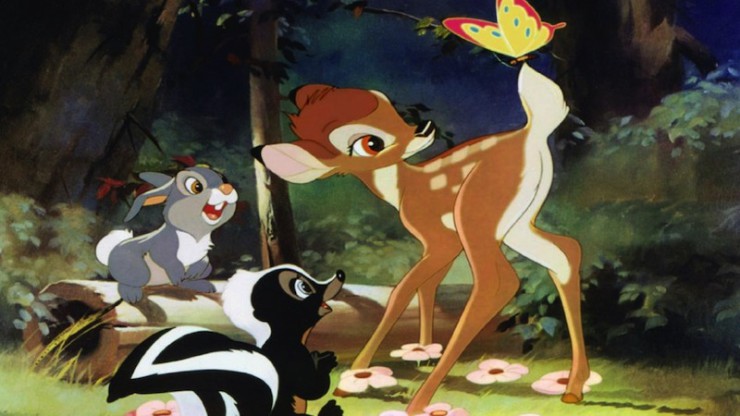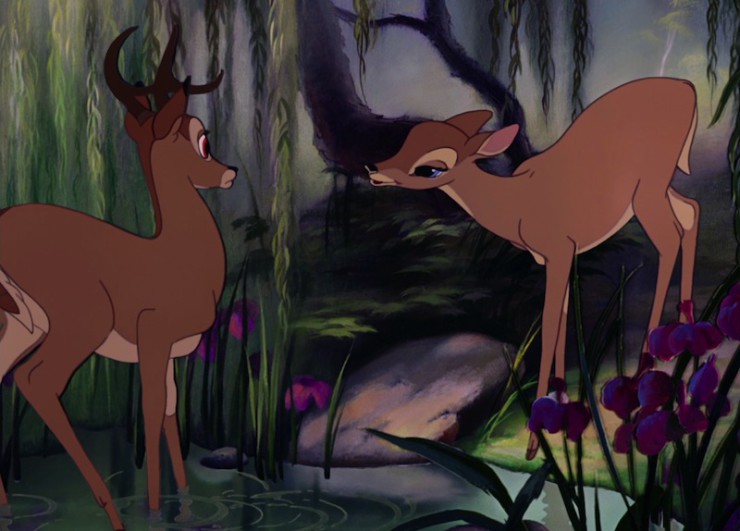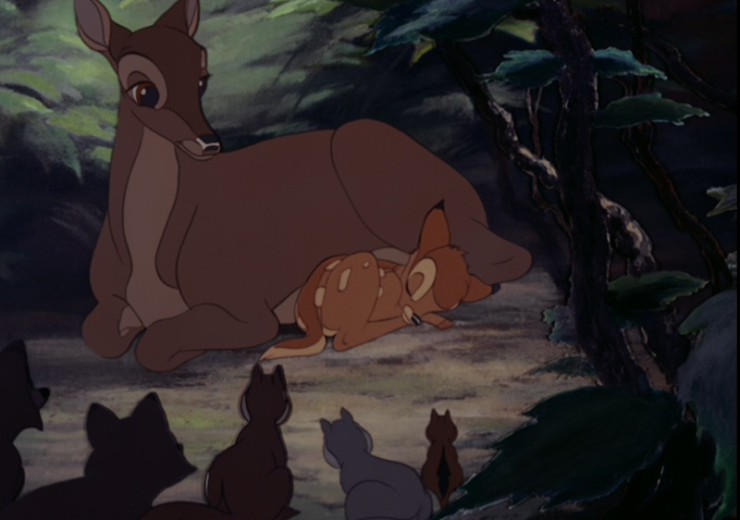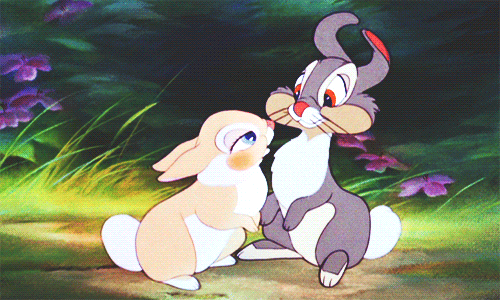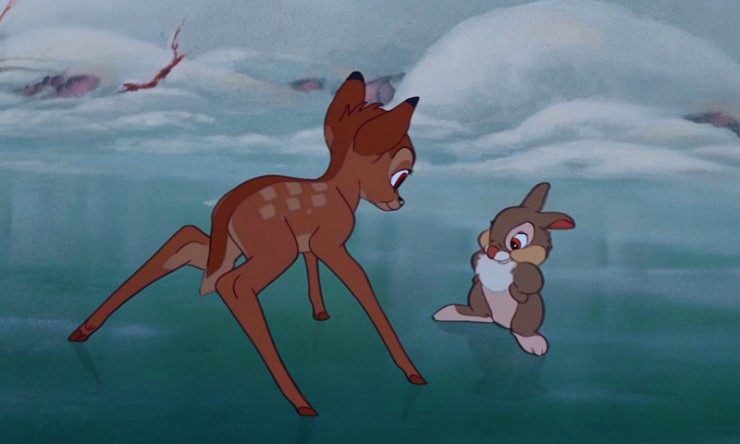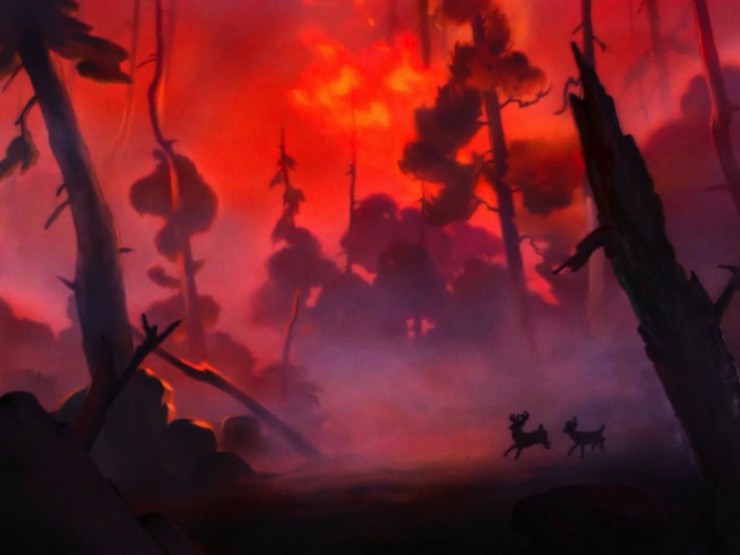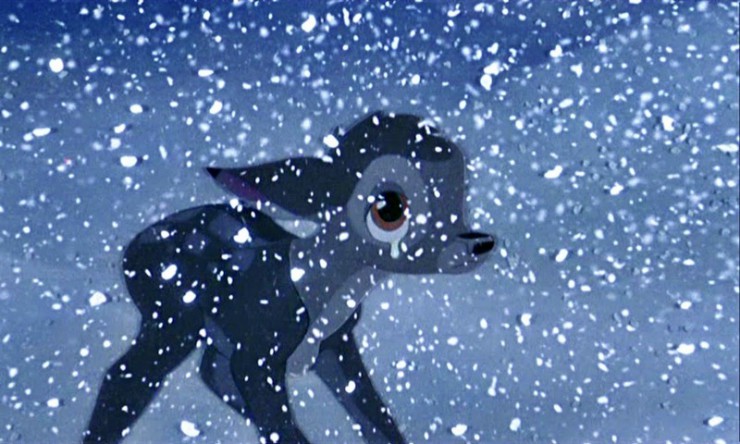Oh, this film.
This film.
Wait. I can do this. I can put together a reasonable, thoughtful blog post on Walt Disney’s Bambi without interrupting the post every few paragraphs with a KILL THUMPER ALREADY, right? I can put aside my feelings about the jarring pacing and tone of the film and the supposedly romantic twitterpating stuff and write some lovely, touching (KILL THUMPER) words about what even I have to admit is a lovely ice scene involving a bunny and an adorable deer on ice, and comment on the great forest fire bit (KILL THUMPER) and put the film into its historic context, with a few words comparing the film to the book. I can do this. I can.
I think.
Walt Disney found himself in a bit of a mess when developing Bambi. His studio was still reeling over the high costs of producing Pinocchio and Fantasia, and the closure of the European film market after Hitler’s invasion of Poland. (In this context, it is perhaps not surprising that Disney insisted on continuing to adapt the anti-fascist, banned-by-Nazis book next, even while assigning animators to the cheaper Dumbo midway through production.) And those were just the external factors. Internally, he had the issue of developing a serious and frankly depressing book into a “Disney” feature, which, to his audience, meant at least some comedy. Oh, Snow White and Pinocchio had their serious moments, certainly, but they had also retained comedic scenes.
And he had the issue of asking his animators to draw animal characters that—because portions of the film would be dealing with serious themes of hunting and death—had look, not like cartoons, but realistic. The Disney animators had managed this more or less in portions of Snow White and Pinocchio, but in both cases, the animators had also put the animals into unrealistic—for animals—situations: housecleaning, smoking, trying to escape evil people who have turned them into donkeys, that sort of thing. The animals in Bambi would be living in a forest and suffering from hunger, just like very real forest animals. It was a new artistic challenge for the animators.
Since the full extent of the Pinocchio financial disaster wasn’t quite apparent at the start of production on Bambi, Walt Disney handled some of these problems the same way he had solved technical problems on Snow White and Pinocchio—by throwing money at them. Lots of money. He sent a photographer to Maine to take pictures of cute forest animals; he brought animals to the studio so that animators could look at actual jumping rabbits, and sent tired animators out to the zoo yet again. Costs leapt up.
The real financial disaster of Bambi, however, turned out not to be live animals, but production speed: animators could churn out about one tenth the number of drawings per day that they had managed for Pinocchio—itself a film with comparatively slow production. To put this in hard numbers: Bambi animators typically created eight to ten drawings per day; Dumbo animators, working at the same time, and free to create cartoon animals not particularly bound by reality or gravity, managed around 120 to 140.
And the real problem with Bambi, as it turned out (BESIDES THE NEED TO KILL THUMPER) was not creating realistic animals and backgrounds, but rather, hinted at right in the title of the book: Bambi: A Life in the Woods. Because the novel is just that: a life. Not what Disney needed: a plot.
Granted, Disney’s films had been relatively episodic in nature. But both were unified by an overreaching plot or theme: with Snow White, escaping the evil queen and marrying Prince Charming; with Pinocchio, becoming a Real Boy; and with Fantasia, creating visuals for music. Bambi: A Life in the Woods has none of that: it’s a work that follows Bambi from year to year, philosophizing about violence and death along the way, but without a central goal beyond survival, or an overwhelming plot beyond the ever present menace of the hunters. And, of course, a high death count.
Snow White and Pinocchio, of course, also had deeply problematic elements and a significant amount of death and violence, so the idea was not, on the face of it, impossible. But the comedy scenes deemed necessary for popular appeal, which had effortlessly flowed in Pinocchio and at least sorta worked in Snow White, proved more difficult with Bambi. Some scenes transitioned well—the dark greys and blues of the opening sequence shifting to the brighter, happier moments of Bambi’s birth.
Others did not. Arguably the worst: the death of Bambi’s mother in the snow—a gripping, emotional sequence that left many small children scarred for life—which is immediately and jarringly followed by a colorful scene of cheerful birds singing about spring. I am entirely on the side of the owl loudly and angrily objecting to all of this, but also, emotionally spinning. An argument could be made, I suppose, that the audience desperately needs something to follow that scene, but not, I would say, that moment. The forced comedy and cheer robs the film of a moment to breathe, and to mourn, and it feels all wrong.
Not quite as wrong, granted, as the scene that follows, when Flower, Thumper, and Bambi all fall in love, just moments after assuring the viewers that they won’t, but wrong.
Speaking of the falling in love stuff, the worst part of that is not, I must say, the misogyny, or the part where Bambi and Rollo fight over Faline. The animation of that is fascinating, as the already softened backgrounds slide away still further, leaving Bambi and Rollo often fighting against colors, and it serves as a nice enough setup for Bambi and Faline’s later relationship. Nor is it the brief moment when Flower meets the love of his life and they trot over to live in the flowers, although that’s not really great either.
It’s, sigh, Thumper’s part.
Here, the animators abruptly dropped the realistic animation used in most of the rest of the film and instead had his lady rabbit vamp out in front of him and seduce him away from Bambi, right down to using sexy poses and long fluttering lashes. I cringed. In another animated film, this would work quite well (mild misogyny aside). In this film, which contains realistic scenes of hunting and starvation, jarring is not quite the word for this cartoon sequence that feels completely out of place.
And since I’ve brought Thumper up:
I know, I know.
Yes, yes, Thumper has his adorable moment of grammatically destroying his father’s command of “If you can’t say anything nice, don’t say nothing at all,” and he doesn’t want to eat his greens aww and he goes ice skating with Bambi how sweet and he grates on me. Oh, how he grates.
For the record, it’s not that I don’t like adorable bunnies. I love them. Thumper’s little brother and sister bunnies? Adorable. Love them. Thumper? No. Also, not that adorable. It’s partly the voice, but mostly the character, who is frequently obnoxious and superior, and often seems to belong to an entirely different film. Thumper’s scenes, after all, are generally played for comedy, in a film where most of the other animals are dealing with the serious notes of hunger and death and fear and hunting in the rest of the film. But beyond that, Thumper is also animated in a looser, more cartoon like style, instead of the realistic approach used for other animals in the film. His ice skating scenes, for example, were patterned on the movements of human ice skaters, not actual rabbits sliding on ice—which is standard for many animated films, granted, but out of place for a film like this which otherwise sticks to having its animals move as realistically as possible.
Thumper, I should note, is not in the original novel, and was added to the film because Walt Disney thought they could have a lot of comedy and fun with a rabbit. Their rival studio Warner Bros would prove them right on this, of course, but while Bugs Bunny is one of my all time favorites, I spent this film hoping that the forest fire would burn Thumper to the ground.
Possibly not the reaction Disney wanted from viewers of this film.
Having said all that, in one sense Thumper does fit in well with other, crueler sections of the film. In scenes where others praise and nearly worship Bambi (for instance,the birth scene, something that would be redone, rather better, by The Lion King decades later), Thumper mocks the little deer, and is often cruel. This has the immediate advantage of turning Bambi into the underdog, someone viewers can sympathize with and root for, and it also works with the rest of the film, with its undercurrents of cruelty and pain.
That function, however, is undercut by another very real problem with Thumper: he, more than any other character in the film, is trying to get Bambi to do very human things like ice skating—thus copying the very people trying to kill him.
And watching that right after reading the book made me shudder.
I know what happened to the animals in the book who did try to be more human, who did work with humans, who did allow the humans to turn them into pets.
It did not go well.
So a film that on the one hand contains lovely little nods to elements within the book (for example, the scene where two leaves fall from a tree, in a homage to the chapter in the novel where those two leaves discuss life and death), but on the other hand contains scenes where Thumper, without irony, attempts to make Bambi more human, strikes a deeply discordant note.
The animators did better with Bambi, who grows from a timid, cowardly, and, if we are to be honest, rather annoying little deer (he is very young) to a bold deer capable of fighting off dogs in order to save Faline, right before they have to flee a forest fire. I am a bit dubious that Bambi would be capable of fighting off a single dog, let alone a pack of dogs, but that scene, plus the earlier hunting moments, and the forest fire, provide the most visually interesting parts of the film, so I guess I can let it slide.
I’m less inclined to let a few other things slide: the forgettable songs (not a single “Whistle While You Work” here, let alone a “When You Wish Upon a Star,”), the jarring emotional changes, and the problem that the parts of this film not involving hunters or fire are often incredibly slow. Bluntly put, much of Bambi might be beautiful, but with the exceptions of the twin scenes with the hunters, it’s also boring.
That is, until the forest fire, a gloriously animated, terrifying sequence, as the animals flee from a terrible fire accidentally set by the hunters. (This scene is not in the book, and was reportedly inspired by accounts of major wildfires in the American west in the 1930s.) It’s astonishing, gripping, and for me deeply frustrating, since it—and other gloriously animated moments—show what Bambi could have been.
Those gloriously animated moments include the rainstorm, the forest fire, the two leaves falling from a tree (a quiet and welcome nod to the book), a snowstorm (animated with the help of cornflakes), and, well, the two hunting scenes. But they’re not enough to make up for the rest of the film, even with a remote control on hand.
I can’t leave the post, I guess, without talking about one of those two hunting scenes—the death of Bambi’s mother. It works, I think, in part because so much of the rest of the film is so slow, so boring, so beautiful, so cute. Death permeates the book; it does not permeate the film, which contains only two deaths—Bambi’s mother and a partridge. Death is so inevitable in the book that it is never a shock. Even knowing that it’s coming, it’s a shock in this film. It doesn’t help that I totally forgot the film has two hunting scenes—and Bambi’s mother does survive the first one. And that in the film, we can see little Bambi, who has never been presented as very intelligent, or very knowledgeable, all alone in the snow, hearing that his mother will never come back.
No wonder so many small children, seeing this, were scarred for life.
It’s powerful, certainly.
Beautifully animated, certainly.
You’re all probably better off watching Bambi Meets Godzilla.
Initial earnings for Bambi were a disappointment, and that was only the beginning of the bad news. As final production inched along in 1941, the Disney animators went on strike; the Japanese bombed Pearl Harbor; and the United States entered a lengthy, two front war. The brand new Walt Disney Studios, built to accommodate the ever growing artistic staff, was commandeered by the United States Army. Bambi turned out to be the latest in a string of financial losses for the studio. It was a disastrous period for Disney—what Roy Disney would later call the “lost years.”
As a result, Disney abandoned the idea of full length, lavishly animated films, instead producing cheap anthology films featuring various animated shorts. We are going to skip most of these, with the exception of the final one in the group: The Adventures of Ichabod and Mr. Toad.
Mari Ness lives in central Florida.










